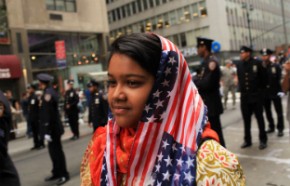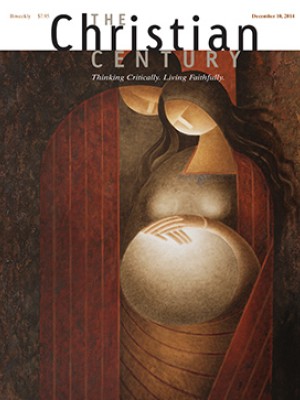Hyphenated life: Mixed loyalties in family and faith

Each summer when I was a girl, my family would drive from Kentucky to Minnesota for our annual visit with relatives. We made the trip in two days, stopping for lunch and breaks at rest areas and the occasional fast-food restaurant.
On the day of departure, I wanted to roll out of bed and right into the station wagon. Instead I was instructed to brush my teeth, wash my face, dress myself in the tidy clothes picked out the night before, and comb and part my hair so that it could be pulled neatly back into my matching barrettes. I remember asking my mom why we couldn’t just wear our comfortable pajama shorts and why we had to fix our hair when we were going to be in the car for two days. She explained that many of the people in the towns along the way had most likely never seen an Asian person before. Therefore, we would want to make a good impression.
For better or worse, from an early age I have been very conscious—and self-conscious—of the thresholds that I cross, thresholds that signal to me differences. Growing up as a minority, not every arena was the same to me. Whether it was a rest area or restaurant along the highway, a school, a church, or a home, I was aware that each arena had its own norms. If I wanted not only to survive but also to flourish, I had to be aware of every threshold that I crossed.
Read our latest issue or browse back issues.
A few years ago, in the company of hundreds of Muslims from the Chicago area, I was struck again by an awareness of thresholds. Clergy from different religious communities had been invited by the Council of Islamic Organizations of Greater Chicago to attend the Muslim community’s annual festive celebration of Eid, marking the end of Ramadan. Eid follows the lunar calendar, and that year it happened to fall on an anniversary eve of 9/11. Muslim communities across the United States were nervous that non-Muslim Americans would not know about this coincidence and would therefore misinterpret the celebrations of Eid as dishonoring the solemn anniversary.
In an effort to prevent such a misunderstanding, the council invited clergy from different religious communities to a press conference at which we could show our solidarity with our Muslim friends. We were also invited to view the program that preceded their prayers. The gathering took place at Toyota Park soccer stadium outside Chicago. Hundreds of Muslim families from the area were seated with their prayer mats, filling the lawn of the stadium.
Before prayers began, several prominent political and civic leaders spoke, expressing their support for the Muslim community. The imam from the Mosque Foundation then spoke about the duty Muslims have to live exceptionally upstanding and moral lives, reflecting the best values of the Islamic faith, so that their neighbors, colleagues, and fellow citizens would come to appreciate rather than fear and even hate Islam. As I heard these words reverberating loudly over the stadium speakers, and noticed so many children in attendance with their parents, it struck me that a whole generation of Muslim Americans would grow up feeling the great weight of self-consciousness.
In Why Are All the Black Kids Sitting Together in the Cafeteria? psychologist Beverly Daniel Tatum describes the development of a minority identity. She reflects on an exercise she uses in teaching in which she asks students to complete the sentence “I am ___________” using as many descriptors as they can think of in 60 seconds.
“All kinds of trait descriptions are used—friendly, shy, assertive, intelligent, honest, and so on—but over the years I have noticed something else,” wrote Tatum. “Students of color usually mention their racial or ethnic group: for instance, I am Black, Puerto Rican, Korean American.” She goes on to say, “White students who have grown up in strong ethnic enclaves occasionally mention being Irish or Italian. But in general White students rarely mention being White.”
Tatum noticed a similar pattern regarding gender, religion, and sexuality. “Women usually mention being female, while men don’t usually mention their maleness. Jewish students often say they are Jews, while mainline Protestants rarely mention their religious identification.” You can see the pattern: “Where a person is a member of the dominant or advantaged social group, the category is usually not mentioned. That element of their identity is taken for granted by them because it is taken for granted by the dominant culture.” The elements of a mainline Protestant’s identity that capture their attention are those that other people notice.
Roman Catholic and Protestant Christians in the United States are a long way from the experience of Christians of the early church who, having endured religious persecution on all sides, must have been self-consciously Christian. Unlike those early generations of Christians, whose words, deeds, and decisions were all suspiciously watched, Christians in this country do not feel so self-conscious.
But a strange phenomenon is happening. I began noticing it when my daughter began nursery school seven years ago. Teachers invited parents to share with the class a holiday celebrated by their families at home. The first mom to visit the class taught the children about Eid. It was a lovely celebration, and the children got a delicious taste of this religious holiday.
A month later, when my daughter wanted to invite her new friend Olivia for a play date on a Sunday after church, she asked me if I thought Olivia also went to church. I suspected that Olivia and her family went to a Lutheran church in our neighborhood, but since I didn’t know for sure, I said, “Why don’t you ask Olivia what religion she is?” Right away my four-year-old dismissed the idea, saying, “Ever since we learned about Eid, everyone says they are Muslim.”
My husband and I came to see our daughter’s nursery school classroom as a microcosm, and during that year we often remarked to ourselves on how much the world has changed since we were kids. Back then, the lines that marked differences in religion, race, and culture were found between social groups; they were social thresholds that we had to cross. Today these lines exist within family units and within individuals themselves. The landscape of difference is not only a social landscape that we can grasp by mapping out who sits where in a cafeteria. It is also an interior landscape that consists of loyalties and commitments that sometimes overlap and at other times compete with one another.
In a Huffington Post blog post written soon after the bombings at the Boston marathon, Eboo Patel, the founder of Interfaith Youth Core, wrote about how intimately most Americans know the experience of having to make sense of their multiple loyalties. “In America, just about everyone is some sort of hyphenated hybrid of race, religion, and ethnicity/nationality. Irish-Catholic-American, African-American, Pentecostal, Jewish-American secular humanist, and so on.” Given this reality, if Americans were asked to complete Tatum’s sentence “I am ___________,” increasingly we would likely fill in the blank with a hyphenated descriptor. About our hyphenated identities, Patel went on to write, “In a nation of hybrids, it’s important to have loyalty to both sides of the hyphen.”
In my own case, I married into a family that includes Roman Catholic parents-in-law, one Jewish brother-in-law, two Muslim brothers-in-law, and just one other Protestant. If we were to identify our whole family identity, we would need many hyphens indeed.
Wanting to gain more insight into how to live with religious difference, I turned a few years ago to a rabbi and an imam to see if we might together hold a monthly dialogue on interfaith homes and families. What the three of us shared in common was the conviction that our religions are indispensable resources for American families, who are increasingly becoming hyphenated. Too often our religions are perceived as barriers to overcome or as baggage to discard, and so people opt not to engage in any religious community at all. The rabbi, imam, and I agreed that this was the worst of all options.
At the monthly dialogues—mostly for premarital and newly married couples, as well as for some grandparents—we tried to provide an alternative option. Discussing practical topics like “How Do You Handle the In-laws” or “How Will We Raise Our Children,” we each draw on our different religions to make sense of and integrate our deepest loyalties.
What we have found in these dialogues with interfaith families is that each member is called to be equally self-conscious about his or her faith. Each person in the relationship bears the responsibility of articulating who he is, what she values, and to whom and what he is committed, so that in their hybrid, hyphenated identities they can be loyal to both sides of the hyphen.
This article is adapted from a speech Shin gave in September at the annual dinner of the Council of Islamic Organizations of Greater Chicago and the Presbytery of Chicago. The dinner is part of a covenant that commits the two groups to working together for the common good with a “genuine concern for the well-being of the other.”





